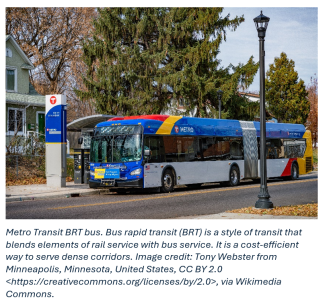Land use and transportation are intertwined and should be planned in coordination. In Minneapolis, coordinated planning has enabled critical new housing and transit. With the right policy reforms, Nashville is poised to see similar results.
In response to housing shortages and growing preferences for walkable living, many cities have reformed zoning codes to enable dense, compact development. Updating a zoning code to permit higher density is one step, but to see the visions of these modern zoning codes come to fruition, cities also need frequent, efficient public transportation systems that boost access to places identified for higher density.
Congress has expressed bipartisan support for building more housing near transit. However, a recent survey of more than 100 metropolitan planning organizations (MPOs), which are responsible for coordinating transportation investments in metropolitan regions, showed that more than 40% say their transportation and housing planning is either barely integrated or not integrated at all.
With half of all homebuyers ranking proximity to public transportation as important in their decision-making and residents in nearly three-quarters of American neighborhoods paying more than what’s considered affordable for the combined costs of housing and transportation, housing policies and transit investments must work in sync to expand options while reducing costs.
Minneapolis shows the benefits of aligning housing and transportation policy
Minneapolis has closely coordinated zoning reform with transit investments, and residents there benefit from more affordable housing and easier ways to get around. The city was cited in an April 2025 Zillow report as one of the most affordable rental markets, with the median household spending about 20% of its income on rent, well below the 30% threshold commonly used to define housing affordability. The city has seen a surge in multifamily housing construction in recent years.
A new zoning code, adopted in 2019, plays a key role in keeping Minneapolis affordable. The code is most known for permitting new “missing middle” housing options by-right in areas previously zoned to only allow single-family detached homes. It also included an impactful provision that set minimum heights and density levels near major transit corridors.
Coupled with removal of minimum off-street parking requirements for new developments—typically a substantial expense for developers—land use policies in Minneapolis are structured to encourage and incentivize new development in well-connected, dense neighborhoods and commercial corridors.
Alongside these land use reforms, Metro Transit, the transit agency serving Minneapolis, has maintained a focus on expanding fast, frequent, and reliable mass transit on key corridors in the region. One of the newest lines to launch, the Metro B Line, provides bus rapid transit (BRT) service with 10-minute headways along a nearly 13-mile route and is anticipated to improve transit travel times by 20%.
Since the route’s launch in June 2025, average weekday ridership has grown to nearly 9,000 riders per day. To put this in perspective, traffic volume data shows around 20,000 daily vehicles on the busiest segments of Lake Street, the corridor that the B Line serves. On such a heavily trafficked roadway, without the B Line, vehicle congestion would significantly increase.
To ensure investments like the B Line are integrated with land use goals, local leaders are allocating additional public funds to incentivize development along transit corridors. Grant funding from the Hennepin County Housing and Redevelopment Authority provides direct financial support to projects that advance transit-oriented development. Across the county, the program has helped create or preserve more than 13,000 housing units, as well as substantial commercial space.
Private developers have also responded to public investments along the B Line. According to the Metropolitan Council, the regional MPO which also houses Metro Transit, 2,300 housing units worth more than $466 million have been permitted along the B Line through 2023, with 31% being affordable. Along with additional commercial and civic developments, just shy of a billion dollars of investment in the decade between the project’s initial announcement and the service start state can be attributed to this transit-oriented corridor.
Housing policy reform can boost the impact of Nashville’s transit plan
In 2024, voters in Nashville approved a sales tax referendum to expand transportation investments, with a focus on public transit and BRT. However, the city’s zoning code hasn’t seen a comprehensive update since 1998.
With only 13% of Nashville’s housing units located within walking distance of a major transit corridor today, new transit investments may fail to reach their full potential if local land use policy isn’t reformed to promote density.
Nashville’s consolidated city-county government, Metro Council, is considering adopting several new zoning districts aimed at closing this gap. Two new pieces of legislation up for a vote this month—to promote density along transit corridors and to enact an incentive program for multifamily projects that include income-restricted units—offer a chance to align Nashville’s transit vision with the kinds of zoning reforms that will support its success. Achievements in Minneapolis demonstrate the value of this integrated approach to planning.
Policymakers have the tools to better integrate housing and transit planning
Progress across sectors isn’t the sole responsibility of any one actor. Still, federal law provides guidelines for how MPOs, in the regional transportation planning processes they lead, can improve cross-sectoral planning. Under updated guidance from the 2021 infrastructure law, Congress encouraged MPOs to consider developing housing coordination plans that aim to “expand housing and economic development within the catchment areas of existing transportation facilities and public transportation services” among other noteworthy goals.
As regional conveners, MPOs are well equipped to spearhead improved coordination with housing and economic development agencies, and recent policy proposals to send more federal transportation dollars directly to regional and local governments would further enable this collaboration. What’s more, although zoning and transit decisions are often made at the local level, states can also play a stronger role by adopting laws to encourage transit-oriented development.
When local and regional policymakers directly integrate their housing plans and transportation investments, communities reap the benefits. Strengthening coordination across sectors and coupling integrated planning with targeted incentives can help deliver transportation projects that support housing goals while moving people in convenient and energy-efficient ways.


